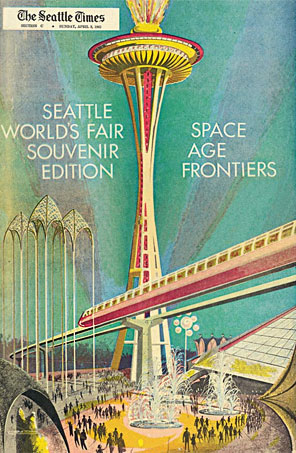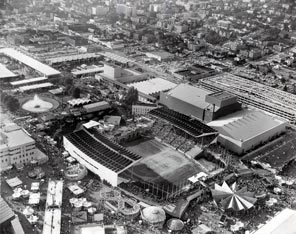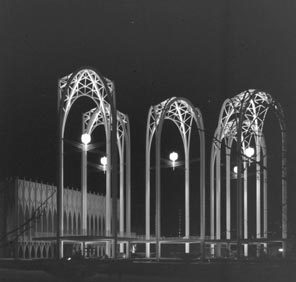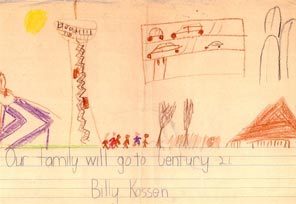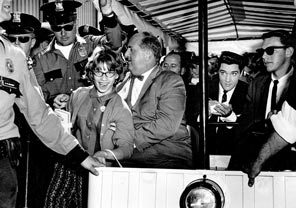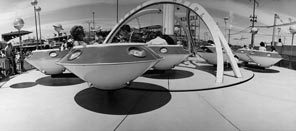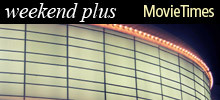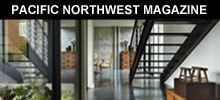Originally published February 18, 2012 at 8:01 PM | Page modified February 19, 2012 at 10:15 AM
1962 Seattle World's Fair: A city in orbit
It's the 50th anniversary of the Seattle World's Fair, a time when the city was flying high with Space Age optimism. We're marking the occasion by revisiting The Seattle Times' souvenir edition published shortly before the fair opened April 21, 1962.
Seattle Times staff
JOHNNY CLOSS / THE SEATTLE TIMES, 1962
This aerial photo of the World's Fair shows the site of what was once a mostly residential neighborhood that was transformed into Seattle Center. In the foreground, Memorial Stadium is packed with fairgoers attending an event. Across the street is the new parking garage, which remains today, too.
SEATTLE TIMES ARCHIVES, 1962
During the World's Fair, the elegant-looking Federal Science Pavilion (now Pacific Science Center) boasted "the greatest scientific display ever assembled in this country."
BILL KOSSEN COLLECTION
Seattle Times desk editor Bill Kossen went to the 1962 World's Fair when he was in the first grade. He drew this picture of the fairgrounds for a class exercise in which he created what appears to be the world's first floating parking garage, drifting up toward the Space Needle. He later got a "D" in art.
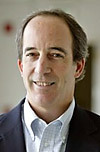
Bill Kossen
1962 SPECIAL SECTION
When the world came to Seattle

On April 21, 1962, the gates opened to a World's Fair in Seattle that left an indelible stamp on the city's image and future.
For 184 days, locals and visitors alike marveled at the Space Needle, the Monorail, the "World of Tomorrow" pavilions, and the "Spacearium."
Days before the opening, The Seattle Times published a 152-page "Seattle World's Fair Souvenir Edition" that was packed with information about the fair as well as predictions for the future. We're celebrating the anniversary by revisiting that section:
![]()
You know our quaint, old monorail that some call the train to nowhere? Well, it was once called "the world's first full-scale rapid-transit system."
And KeyArena, blamed a few years ago for not being big enough and cool enough to keep the Sonics here, was "one of the largest clear-span buildings in the world."
Then there is the Pacific Science Center, which today says it has "Seattle's biggest screen." Back then, it housed "the greatest scientific display ever assembled in this country."
Yes, Seattle was one swaggering city of Space Age superlatives when it put on the 1962 World's Fair.
The excitement and hype had been building for years when The Seattle Times on April 8, 1962, published a 152-page, six-section souvenir edition dedicated to the World's Fair. The sections were packed with stories brimming with civic optimism and statements of superiority.
And why not?
This remote outpost in a rainy corner of the country was booming. Seattle was home to Boeing, and the sky was the limit. So build that Space Needle with the rotating restaurant and the flaming top and let the world revolve around it.
And it did for six glorious months.
It all began in the early 1950s with a civic leader suggesting that Seattle needed a "shot in the arm" fair to attract attention to some big projects being discussed around here, such as a freeway and a bridge across Puget Sound.
But that idea was shot down, according to a story in the first section titled "Space Age Frontiers."
A few years later came a suggestion to celebrate the 50th anniversary of the 1909 World's Fair in Seattle. Getting closer. Instead of looking back, though, the final plan for the fair looked to the future — and the rest is history.
And much of that history is contained in the hundreds of stories, photos and advertisements in the special sections.
It wasn't all geeky scientific stuff. Seattle came across as a place to have fun and enjoy the natural beauty of the Northwest. Where you can buy a new home with "tomorrow's pleasures and convenience."
And all you visitors from out of town, you will "enjoy pleasant weather ... Seattle is seldom hot. The summer sun feels good in Seattle."
Soaring above everything at the World's Fair and on the cover of the "Space Age Frontiers" section was the Space Needle with elevators that moved with "rocketlike speed" and a 40-foot "crown of flame" natural-gas torch at the top. (The flame was later extinguished.)
The "Space Age" section contained at least 68 images of the Space Needle (we quit counting after that) — in advertisements, news photos or sketches that were simply used to plug empty space on the pages.
Most of the advertisements that included the Space Needle had little or nothing at all to do with it or the World's Fair, such as the one for Northgate, another symbol of the future that could boast of "free, easy parking for 5,000 cars."
The message was clear: If you wanted to catch someone's eye, flash that Needle.
You could even buy a 25-inch-tall replica of the 605-foot Space Needle made out of "durable ZAMAK metal" (a zinc-aluminum alloy) that also served as an ashtray.
"It is one of the modern day wonders of the world," the ad said, blurring the line between the icon-to-be and the ashtray. And it was yours for only $16, including shipping. That ad, by the way, is on a page with six images of the Needle.
Amid all the glory and optimism surrounding the 1962 Seattle World's Fair, however, was a hint of impending doom. It was the era of the Cold War and atomic bomb and that came through in the special edition.
"But what about Century 21? Will there be a Century 21?" asks a story that describes the World of Tomorrow exhibit in the Coliseum. The exhibit included "a grim fallout shelter, housing a family — it could be any family."
The story didn't dwell on it, however. It was mostly about the Coliseum's "fantastic cloud" of 3,662 aluminum cubes that stood 60 feet high, "an engineering marvel ... as complex as an electronic computer."
The section ended on a high note, looking ahead to when the fair would be over and the grounds transformed into a civic jewel known as Seattle Center.
"If everything works out," the story concluded, "Seattle can look forward to quite an inheritance from the last will and testament of the World's Fair."
You can explore more of the special edition in The Seattle Times soon. The schedule is:
March 5: "Modern Living" — Highlights include a story about Space Age closets, a trend toward two-pool homes and an ad for the "World's Largest Penney's" in downtown Seattle.
March 19: "City of Tomorrow" — The dominant image on the cover of this section shows a city of skyscrapers with a wide-open freeway running through it. Back then, it looked like Gotham City. Today, it looks like Seattle, but a Seattle with a lot less traffic.
The section includes lots of ads about the cool, new suburban developments in Bellevue.
April 1: "Industrial Horizons, Part 1" — Our industrial horizon was bright, what with the cover illustration showing a moon-bound spacecraft carrying enough rocket power to reach Alpha Centauri. The section includes such stories as "Boeing Is in Space Age to Stay; Has Two Billion Backlog" and a photo headlined: "Artist's Concept of Moon Colony."
April 15: "Industrial Horizons, Part 2" — "Seattle, the boating capital of the world," begins the first story in this section that helps establish Seattle, circa 1962, as the superlative capital of the world.
As it should be. In a world of fairs, Seattle's was the best. I know. I was there.
Bill Kossen: 206-464-2331 or bkossen@seattletimes.com







